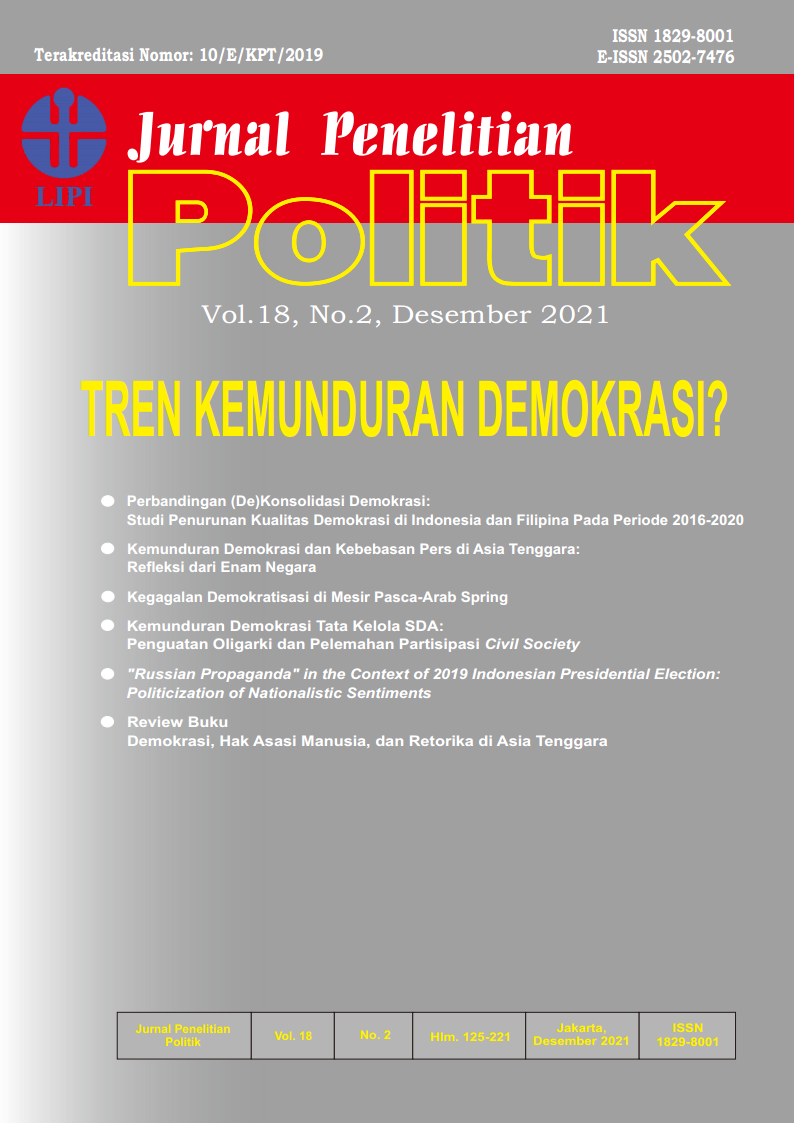KEMUNDURAN DEMOKRASI DAN KEBEBASAN PERS DI ASIA TENGGARA: REFLEKSI DARI ENAM NEGARA
DOI:
https://doi.org/10.14203/jpp.v18i2.1028Keywords:
democratic decline, freedom of the press, Southeast AsiaAbstract
Freedom of the press and the development of democracy are intrinsically intertwined. However, the trend of
democratic decline globally also negatively affected press and media freedom, including in Southeast Asia, where
scores on the democracy index stagnated and tended to decline. This article selects six of the eleven countries in
Southeast Asia as the object of comparison, namely Timor Leste, Indonesia, Philippines, Singapore, Malaysia,
and Thailand. A comparison was made on several aspects of press and media freedom in the six selected countries
using survey data obtained through V-Dem, Freedom House, and Reporters Sans Frontières (RSF). The descriptive
analysis was conducted through literature related to the conditions of democracy and freedom of the press in six
countries. The aspects of press and media freedom compared include government censorship efforts, harassment
of journalists, media bias, media corrupt, and media self-censorship. Through a comparison of six countries, it
generally reflects that the condition of press and media freedom has linearity with the trend of democratic decline.
In countries with declining democracy scores, press and media freedom scores also decline. In most Southeast
Asian countries, commitments to freedom of the press are generally undermined by laws and regulations that place
restrictions, tight controls, and intimidation on media organizations and journalists. This practice most clearly
reflects the democratic decline in Southeast Asia
References
Aminuddin, M. F. (2020). Populist Promises, Democratic Fissures: Indonesia and the Philippines. Global Asia, 15, (1). https://globalasia.org/v15no1/cover/populist-promises-democratic-fissures-indonesia-and-the-philippines_m-faishal-aminuddin.
Bermeo, N. (2016). On Democratic Backsliding. Journal of Democracy, (1), 5-19, doi:10.1353/jod.2016.0012.
Coppedge, M., et al. (2020). V-Dem Dataset v10. Varieties of Democracy (V-Dem) Project. https://doi.org/10.23696/vdemds20.
Deane, J. (2015). Media and communication in governance: It’s time for a rethink. Dalam A governance practitioner’s notebook: Alternative ideas and approaches (eds. A. Whaites et al.). OECD – DAC.
Diamond, L. (2020). Democratic Regression in Comparative Perspective: Scope, Methods, and Causes. Democratization 28(1), 22-42.DOI: 10.1080/13510347.2020.1807517.
Fong, S. Y. (2015). Censorship as Performance: A Case of Singapore Media Production. Dalam Media, Margins and Popular Culture. (hlm. 202-215). Palgrave Macmillan.
Freedom House. (2014). Freedom in the World 2014.Rowman & Littlefield.
Freedom House. (2020). Freedom in the World. Diakses dari https://freedomhouse.org/report/freedom-world.
Høiby, M., & Ottosen, R. (2019). Journalism under pressure in conflict zones: A study of journalists and editors in seven countries. Media, War & Conflict, 12(1), 69–86. https://doi.org/10.1177/1750635217728092.
Howard, M. E. (2019). How Journalists and The Public Shape Our Democracy From Social Media And “Fake News” To Reporting Just The Facts. Georgia Humanities Council.
Levitsky, S. & Way, L. (2015). The Myth of Democratic Recession. Journal of Democracy 26(1), 45-58. doi:10.1353/jod.2015.0007.
Levitsky, S. & Ziblatt, D. (2018). How Democracies Die. Crown.
McQuail, D. (1987). Mass communication theory: An introduction. Sage Publications, Inc.
Ramadlan, M. F. S. (2019). Perkembangan Demokrasi dan Paradoks Kebebasan Pers di Indonesia: Tantangan dan Hambatan dalam Relasi antara Pers dengan Negara. Dalam Ramadlan, M F S. dkk, Media, Kebudayaan dan Demokrasi: Dinamika dan Tantangannya di Indonesia Kontemporer (hlm. 1-35). UB Press.
Reporters Without Borders. (2020). 2020 World Press Freedom Index. France: RSF. https://rsf.org/en/ranking/2020.
Repucci, S. (2019). Freedom and the Media: A Downward Spiral. Freedom House. https://freedomhouse.org/report/freedom-and-media/2019/media-freedom-downward-spiral.
Repucci, S. & Slipowitz, A. (2021). Freedom in the World 2021: Democracy Under Siege. Freedom House. https://freedomhouse.org/report/freedom-world/2021/democracy-under-siege.
Stier, S. (2015). Democracy, autocracy and the news: the impact of regime type on media freedom. Democratization, 22(7), 1273-1295. DOI: 10.1080/13510347.2014.964643.
Tapsell. R. (2017). Kuasa Media di Indonesia: Kaum Oligarki, Warga, dan Revolusi Digital. Marjin Kiri.
Trappel J. & Tomaz T. (2021) Democratic performance of news media Dimensions and indicators for comparative studies. Dalam Josef Trappel & Tales Tomaz (Eds). The Media for Democracy Monitor 2021. Vol. 1. Nordicom University of Gothenburg.
Waldner, D. & Lust, E. (2018). Unwelcome change: Coming to terms with democratic backsliding. Annual Review of Political Science, 21(1), 93-113, https://doi.org/10.1146/annurev-polisci-050517-114628.
Warburton, E. (2020). Deepening Polarization and Democratic Decline in Indonesia. Dalam Carothers, T. & O’Donohue, A. Political Polarization in South and Southeast Asia: Old Division, New Dangers (hlm. 25-40). Carnegie Endowment for International Peace.
Wijayanto & Hasfi, N. (2021). Kebebasan Pers dalam Ancaman: Indonesia setelah Dua Dekade Reformasi Politik. Dalam Aminuddin M. F & Prasetyawan, W. Pasang Surut Demokrasi: Refleksi Politik Indonesia 1999-2019 (hlm. 103-138). LP3ES.
Yang, A., (2012). Assessing Global Inequality of Bribery for News Coverage: A CrossNational Study. Mass Communication and Society 15(2), 201-224. doi: 10.1080/15205436.2011.566826
Downloads
Published
How to Cite
Issue
Section
License
Copyright (c) 2021 Author(s)

This work is licensed under a Creative Commons Attribution-ShareAlike 4.0 International License.

